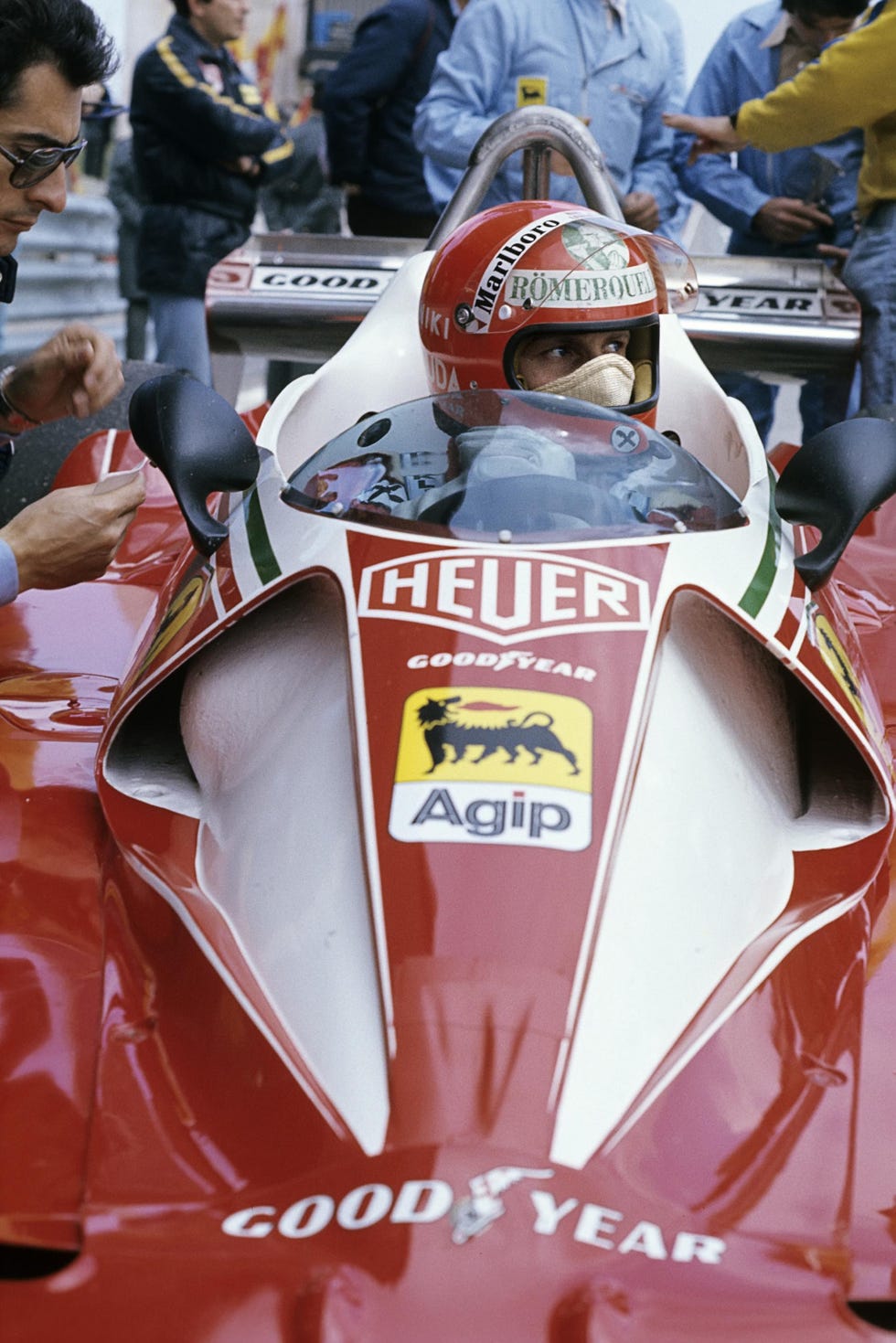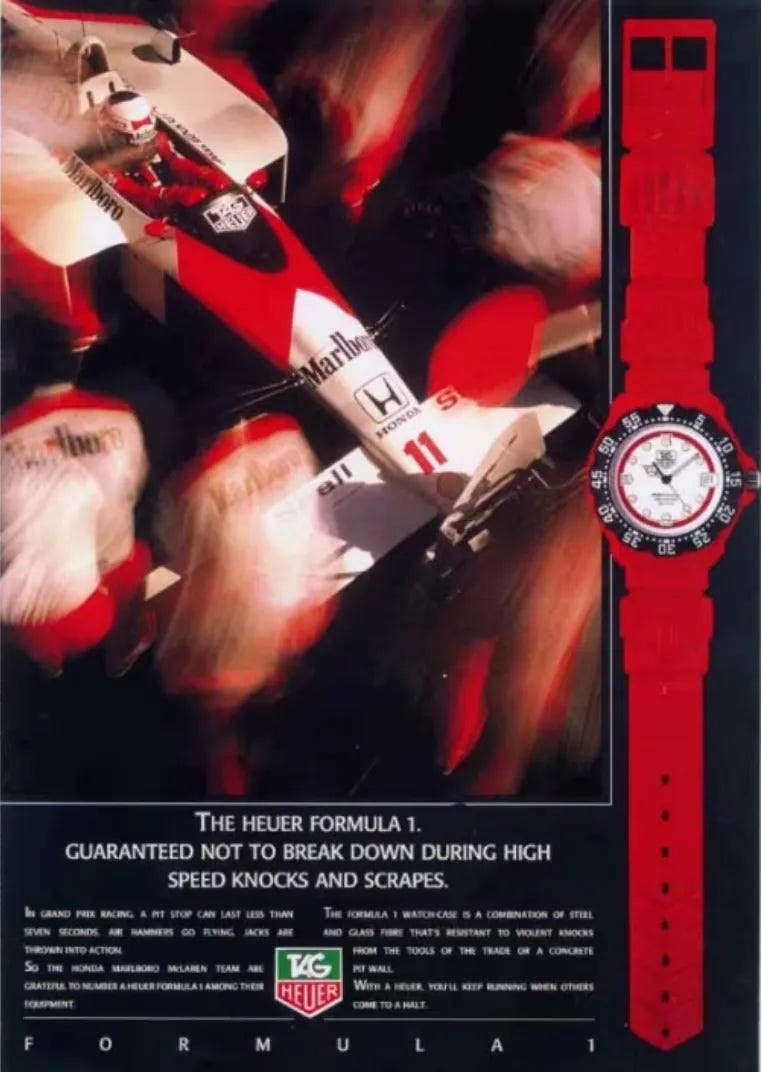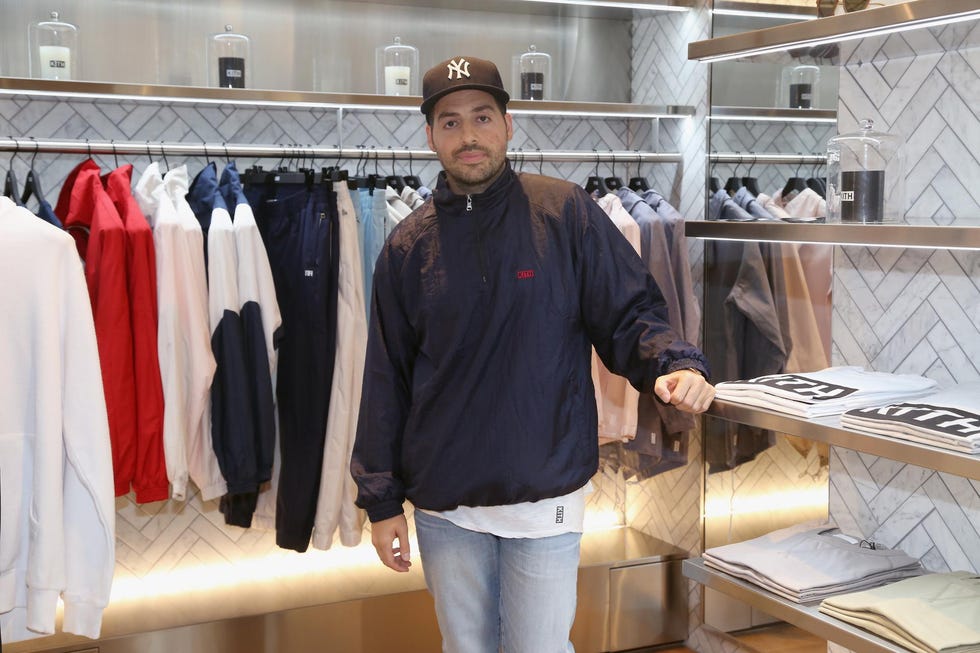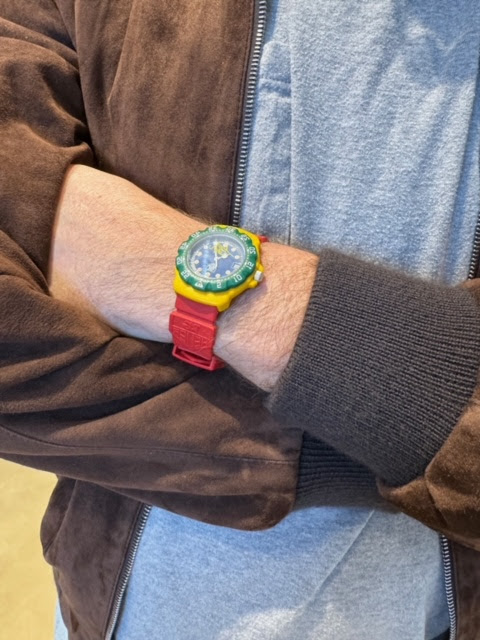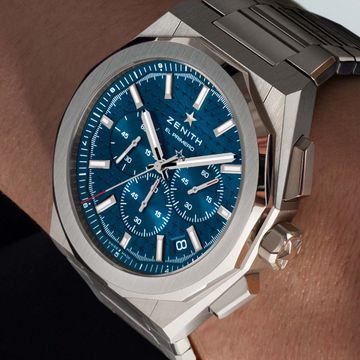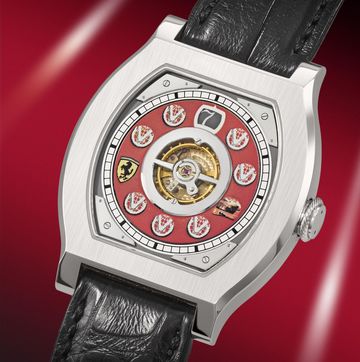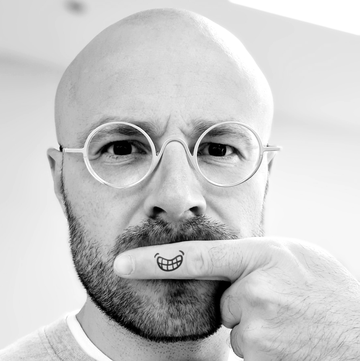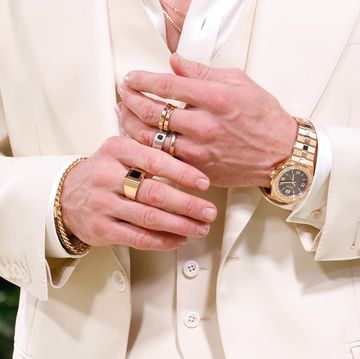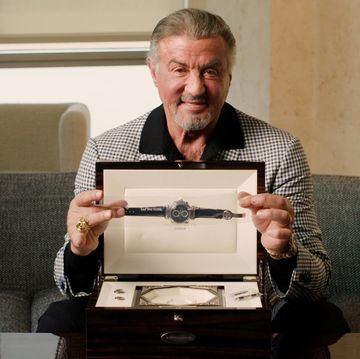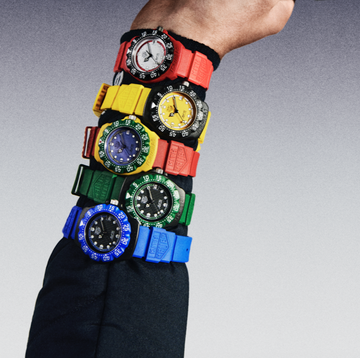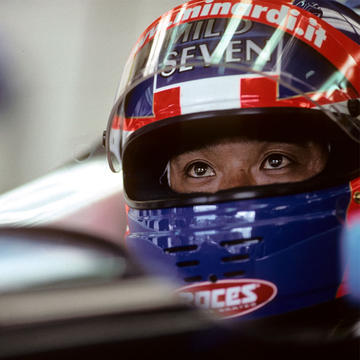This story is taken from Esquire's About Time newsletter, style director Johnny Davis’s straight-talking take on the wonderful world of watches. Sign up here.
On Wednesday, Tag Heuer pushed the start sequence on what may have been the worst best-kept secret in watches.
It was bringing back the original 1980s run of its Formula 1 edition.
The Formula 1 line has been fixture of the brand for decades, and today comes in many different versions and materials, from special editions for the Indy 500 to one in memory of Ayrton Senna. It serves as both Tag Heuer’s ‘entry level’ watch [a steel 41mm Formula 1 Date will set you back £1,350] and an up-market one [the Mario Kart Limited Edition Tourbillon for £21,250. Oh yeah! Mario Time!].
But, in its original run, from 1986 to 1990, known as Series 1, it came in plastic and stainless steel – and a variety of pop colours.
It was cheap, it was quartz, it sold by the bucketload.
Calls for its return have come from all quarters – not least in this Esquire article – prompted by a wave of 1980s and 1990s nostalgia, and the success of the MoonSwatch, the plastic version of Omega’s Speedmaster that became a best-selling phenomenon.
Tag Heuer’s 2024 versions of the Formula 1 Series 1 have added some updates to the strap (rubber, not plastic) and the crystal (sapphire, not plastic) and have been produced in association with Kith, the American lifestyle brand known for its popular but pricey limited-edition collabs.
What follows is an oral history of the original Formula 1 watch, and the story of how this week’s new collaboration – officially called ‘Tag Heuer Formula 1 | Kith’ – happened.
Part One: Motorsport
Before it became Tag Heuer, there existed the watchmaking and chronograph company Heuer – founded in 1860, by Edouard Heuer. By the mid 20th-Century Edouard’s great-grandson Jack Heuer, marketing giant and motor racing fan, was taking the business global
Jeff Stein, founder and owner of OnTheDash, and vintage Heuer historian: In 1962, a very young Jack Heuer – 30 years old – came to the United States, essentially, to peddle stopwatches. Heuer wondered why the market share was so high in the rest of the world and relatively low in the United States. He would pack up every weekend and head for a racetrack – sometimes it was [a] very professional [one], Sebring or Daytona. Sometimes it was just a local amateur road rally. He really set his eyes on motorsports and rallies and races from the start. Motorsports, and specifically Formula 1, was a realm shared by both Heuer and Techniques d’Avant Garde [Tag, the company that would acquire Heuer in 1986]. Heuer had been a Formula 1 sponsor since the late 1960s, achieving great success with Ferrari in the 1970s. Tag was the principal sponsor for the Williams team from 1979 to 1981, before buying 50 per cent of McLaren in 1981. The McLaren / Tag team would win world championships in 1984, 1985 and 1986, with Niki Lauda and Alain Prost.
Nicholas Biebuyck, heritage director, Tag Heuer: The first-generation Formula 1 [watch] is kind of emblematic of the establishment of Tag Heuer as a company. It was family-run, from 1860 to 1982, across four generations. In 1982, with the quartz crisis [the dawn of inexpensive battery-powered watches], we were acquired by Piaget, of all people. And Piaget basically killed off most of the mechanical chronographs and really pushed forward with the dive watches – the 1000 Series, the 2000 Series and the 3000 Series. But in the middle of all of this – 1983 – Swatch launches in Bienne [Switzerland]. Where is Tag Heuer based? Bienne.
Jeff Stein: By the late 1970s the traditional Swiss watch brands and the chronograph manufacturers were in trouble. Because of quartz and the strengthening of the Swiss franc versus the US dollar. Many brands went under – into receivership or liquidation. Heuer hung on, basically on the strength of dive watches. In the late 1970s skin diving and scuba diving were becoming popular sports and Jack Heuer would say, unapologetically, that was what he was going to get into. He was going to shows and conventions, and people were looking at the Rolex Submariner and saying, ‘I wish there was a more affordable version of this’. So, beginning in 1978/79, Jack Heuer went all in on dive watches. It was really that experience, into the early 1980s, that positioned them to design the Formula 1. It was a fully-fledged dive watch, 200-metre waterproofing. It just happened to be in a fun shape with fun colours. It was leveraging the experience in dive watches that really became a lifeline to the company.
Nicholas Biebuyck: The internal team had started to develop an entry-level quartz watch, to not compete directly with Swatch. But to basically give people a gateway into Swiss watchmaking. As Piaget were guiding Heuer, they saw what was happening with Swatch, and they saw a chance to do a kind of premium version. It was well into development when, in 1985, Tag decided to go ahead and acquire the brand. So, on January 1, 1986 we officially become Tag Heuer SA – uniting the green of Saudi Arabia [Tag's owner Akram Ojjeh, who died in 1991, was a Saudi naturalised Syrian businessman] with the Tag arrow logo, and the white and the red of the Swiss flag. And Formula 1 turns out to be the very first watch to launch wearing this new Tag Heuer logo. And not subtly. It’s on the dial. It’s on the strap. It’s on the case back.
George Ciz, chief marketing officer, Tag Heuer: The Formula 1 was the first watch that had ‘Tag Heuer’ on it. The heritage stories that we have around is amazing. The amazing old ads. It’s a super-important watch.
Jeff Stein: It was a reaction to Swatch. Quartz, plastic, colourful – almost an infinite variety on the palette, so many different colours and combinations. But it was clearly a much better watch than the Swatch itself. It came a couple of years later. Better waterproofing to 200m, better movement, unidirectional rotating bezel. The combination of steel and composite.
Nicholas Biebuyck: In fact, Heuer had tried this a decade earlier, with something called the Easy-Rider, positioned under the Leonidas brand [another watchmaker that merged with Heuer in 1962]. There was even an edition done with Jacky Ickx, who was a Ferrari driver at the time, and we launched the watch in ’73. Reinforced plastic case, inexpensive sealed plastic movement – in yellow, red and blue. And this was positioned at a very similar price point to where the Formula 1 arrived in 1986. So clearly, there was something in the minds of people in the industry at the time, that a more accessible watch needed to be produced in Switzerland. That was the first crack at it. It didn’t work because the movements were too unreliable.
Jeff Stein: Nowadays, race car drivers get out of the car and go to the podium and somebody slaps a watch on them [for the photo opportunity]. When you look at the photos from the 1960s and 1970s you see groups of drivers sitting on the Armco [crash barrier] – racing suits unbuttoned. And you see them looking at their watches, feeling their watches. It was part of the uniform. The watches weren’t collectables then. They were tools. Lauder, Senna, Andretti, Prost, Hunt… Andretti was wearing an 18ct gold Heuer in a tiny cockpit, metal on metal!
Nicholas Biebuyck: Clearly it was something that was coming. And with [Tag's] Mansour [Ojjeh Akram’s son and successor] and Akram, the passion for motor racing, their ownership of McLaren, it was just totally serendipitous. The other big technical leap was arnite – engineered thermoplastic that had arrived in the late 1970s, that has a very high melting point. It’s very robust. It’s very resistant to chemicals. It’s predominantly used for insulating housing, for electrical switchboards. It’s pretty much perfect for that. But you can also make it in any colour you want. Which is why, from 1986 to 1995 – during that time, we had 37 core pieces [in the Formula 1 line] – plus the various logo dials – the Olympics, Kenwood, BP, Indianapolis Speedway, Shell. But the lion’s share [of the colours] came at launch in 1986, in the first catalogue. The design for the period was so unusual. Hooded lugs, faceted case – kind-of dive [watch] codes, but a bit motorsport as well. The designer, Eddy Burgener, got a royalty on every single one. And we sold three million of them. So he did alright.
Jeff Stein: When [Steve] McQueen was making the [1971] film Le Mans, he wanted to look like Jo Siffert. Siffert was the Swiss Formula 1 driver who had a relationship with Heuer. He had a Heuer patch on his racing suit. He had a Heuer decal on his car. He wore a Heuer Autavia chronograph. And he used to sell Heuer chronographs to other drivers and teams. So, McQueen wore the Heuer [branded] racing suit. And the Heuer Monaco [watch]. And there it was. That was the imagery that Heuer used when they came out with the Formula 1 watch in the mid-1980s, when you look at the catalogues and [promotional] materials, it’s Senna, Berger, Schumacher… But when you boil it all down, it was a dive watch. And then it became a chronograph [in later iterations], around 1989.
Nicholas Biebuyck: Ukyo Katayama has had an amazing career. He was first in class and second overall at Le Mans in 1999. But when he started in Formula 1 he was driving for this bizarro team, Larrousse, with a Lamborghini-powered engine called the [Venturi] LC92 and the livery of the car was the same as [a special edition Tag Heuer would go on to produce, now the most sought-after of the first run of Formula 1 watches]. It was like every colourway under the sun. The fact that we signed a deal with him was great because Japan was a very important market for us. We could see that engaging a Japanese driver would be very beneficial.
One obvious factor that helped the success of the Formula 1 watch collection? Its name
Jeff Stein: It is nothing short of miraculous that Tag Heuer was able to get the ‘Formula 1’ name. It seems so obvious, and so compelling, but there is really no other brand that could have claimed this position in the watch world. Of course, Rolex had the Daytona and Omega had the Speedmaster, but in the mid-1980s and into the 1990s, Tag Heuer had a unique position in motorsports, generally, and Formula 1, specifically. Tag Heuer was the official timekeeper of Formula 1 from circa 1992 to 2004 and has had the same role with the Indianapolis 500 and many other leading races. Tag Heuer also sponsored Formula 1 champions Ayrton Senna, Gerhard Berger and Michael Schumacher in the early 1990s.
Nicholas Biebuyck: I have to laugh every time I hear the name. How anyone would let you call a watch ‘Formula 1’. It goes to show it was a different time. Bernie Ecclestone and [chassis builders] FOC, the Formula One Constructors Association… the promoters were running the races. Bernie owned – quote, unquote – the IP of Formula One. My guess is that because Akram had McLaren, and McLaren was absolutely vital to Formula 1 at the time – [rivals/teammates] Senna and Prost were the lead characters of the moment – I’m sure [Akram] was just, like, ‘I'm gonna call my new watch the Formula 1’. And Bernie was, like, ‘Yeah, sure, whatever!’ These days you have naming agencies and namingcommittees, and everything else. But this is such a perfectly named watch for such a perfectly timed moment that I don’t think you could repeat it.
Jeff Stein: They sold three million of these first-generation watches and chronographs. You can still pick them up on eBay and they’re still running. That’s a good quality movement! And that has fed into the collecting community.
Part Two: Nostalgia
Ronnie Fieg, owner, Kith: The Formula 1 was the first watch I ever owned. My mom used to work at [US watch retailer] Tourneau and she bought it for me for my 13th birthday. I remember she hit her sales goal at work for that month and was so excited that she could finally buy me a watch. It was a 28mm and I fell in love with it. As I got older and began making my own money, I started collecting 35mm’s, which is how I began my journey of becoming a watch collector.
Jeff Stein: The 1995/1996 Tag Heuer catalogue described the Formula 1 collection as the ‘sports watch for the young’, referring to it being made for ‘today’s fast-moving, hard-playing action generation’. The catalogue referred to these watches being perfect for paragliding, windsurfing, white water rafting and ‘of course, rally racing’. There was a generation whose first real watches were the Heuer dive watches – Barack Obama with his 1500 Series and Bill Gates with his 2000 Series – and there is a generation whose first real watches were the Formula 1 watches. Survey today’s collectors in their 40s and 50s, and many will confirm that the first watch that they remember are the Swatches, the Formula 1s or the other Heuer dive watches.
Ronnie Fieg: I started to collect Formula 1 watches on my own around the early 2000s. At the time, I was mostly sourcing them from Japan, as there were a lot of collectors there. Most of the ones I own I never wore, so the straps are still their original lengths. Every now and then I would pick a new one up that I came across, so the collection has been steadily growing since then.
Nicholas Biebuyck: I always said when I joined Tag, I’m wasn't going to buy watches myself. But the Formula 1 Katayama [edition] was always the one I wanted, badly. And 18 months ago, I got it. One had been sitting on eBay for months, for $500 or something. And no one else has snapped it up – now prices have jumped quite a bit. More to do with the enthusiasm for composite quartz watches. But, of course, massive nostalgia as well. Everyone just loves the first-generation Formula 1.
George Ciz: The watch media has been demanding that we bring it back. They keep telling us to do something with it. But you know when [its appeal] was most apparent to me? Two years ago in Miami, we did an activation and we organised a go-karting experience in the Design District in [outdoor event space] Jungle Plaza. And fans could come in and race against each other. It was awesome, it was really good fun. And we displayed watches with racing heritage. And, of course, this original Formula 1 was there. And of all the watches, I could see everybody was really focused on it. It’s, like, ‘Wow, that's really cool!’ The interest that watch got was massive.
Part Three: The Return
George Ciz: Ronnie Fieg was a huge part of this. He approached us to talk about it – and that’s where it started, the collaboration idea. Obviously, this piece has been on the radar for a while, but it was he who came to us. This was the catalyst.
Ronnie Fieg: This has been in process for over two years now. I was at a dinner a couple of years ago and was sitting next to [then CEO of Tag Heuer, now CEO of LVMH's whole watches portfolio] Frédéric Arnault. We connected pretty quickly and were talking about all things watches. I told him the story about how my first-ever watch was a Tag Heuer Formula 1 and showed him a picture of me wearing it when I was 13 years old. He loved it, and we set up a time to discuss a concept around the Formula 1 further.
Nicholas Biebuyck: We found the supplier who made the cases in the first instance, and they had the original mould, so [the 2024 versions are] biometrically exactly the same as the original watch. We were lucky because we just did a project to digitise some of our early schematics with our development team. And within that, we found the original drawings with the name of the supplier. At the same time we’ve upgraded the materials: sapphire crystal DLC-coated steel cases, rubber instead of plastic for the straps – when you hold the two up side-by-side they feel substantially different.
Ronnie Fieg: The Formula 1 Series 1 is such an icon that we had to pay homage to the original version. It was a design ahead of its time, which is evident when you see these new models and how well they fit in today’s landscape. However, Tag Heuer isn’t the exact same brand they were in 1986 so we did make some premium upgrades. We updated the original plastic crystal to sapphire and replaced the original plastic straps with a higher quality rubber. These new versions are really special because they’ll give the collectors that same look and feel, but with an upgraded offering.
Jeff Stein: Of course, the success of the MoonSwatch has set the stage for Tag Heuer to go back to the roots of the Formula 1 collection, the first-generation models from 1986 to 1990. A range of bright, colourful watches, that will perform well – well-built watches with good quality movements – and be priced at the brand’s ‘entry level’ price, should be very successful. Add a collaboration with a leading ‘lifestyle’ brand, with the watches offered in limited editions, there should be huge demand. The first-generation Formula 1 watches evoked the colours of racing. The revived collection can evoke vibrant destinations [some are named 'Miami', 'Tokyo', etc] that are popular with today’s travellers.
George Ciz: This is a very different topic than the MoonSwatch because there you’re taking the Omega name and putting it on a Swatch watch. This is a Tag Heuer team timepiece. It’s very, very different to bring the original back. It’s an homage to our origins. And that’s a bit different from expanding the look of your amazing, classic piece to a lower price segment. We're celebrating our past.
Ronnie Fieg: Kith is the perfect collaborator because it comes from such an authentic place for me. The Formula 1 played an important role in my life as it was the timepiece that got me into watches and made me a collector. I say this all the time but the things you love between 13 and 16 years old are the things you’ll love forever. Frédéric and the team felt the passion I have for this model, and recognised I had an honest story to tell.
Nicholas Biebuyck: Right now, there are a lot of collabs in the luxury market. Many would say too many. And we made a conscious effort to not take every opportunity that was given to us. Many, many people come to us and say ‘We want to do something with Tag’. We are very, very selective. But when you have a story as compelling as the one Ronnie presented – it felt a very serendipitous moment. The fact that we were bought together with this great moment, when nostalgia was running high, and we had a great product... it made a lot of sense to bring it back.
George Ciz: Absolutely, a plastic watch can be luxury. But I think this is more than a plastic watch. It’s much better than the original, let's be clear – it’s more elevated. And, like I said, I think luxury can come in many different ways. This has the authenticity story. It has the scarcity story – only very few people will have this. So it’s super-special. It has exciting aesthetics. We have seen luxury play on colour in recent years. Look at [Louis] Vuitton and [Japanese pop artist Yayoi] Kusama. Many colours that we have – yellow, green, red, blue – are the same. And then we have the association with the world champions. Our world champions are going to be wearing it. We’re going to do a collectable box set. [A presentation box containing all 10 watches, limited to 75 and said to be priced around CHF 18,000 [£15,600]]. So, in my opinion, it has all the ingredients.
Nicholas Biebuyck: In today’s world, where you can walk into Louis Vuitton and buy some accoutrement for relatively low value, all the way up to something totally bespoke, I think we can see brands stretching luxury into a very different position to where it was, even five years ago. There's no reason why we can't sell a $1,500 Formula 1 all the way up to $150,000+ Monaco rattrapante [uber-high-end titanium Monaco Split-Seconds Chronograph model, announced last month]. We want to make the very best at every position that we have for the collection.
Jeff Stein: The irony here is that Tag Heuer just introduced a state-of-the-art Monaco for CHF135,000. I think we’re seeing a lot of brands do that. They want the entry level. And then they want the ultra-luxury. So I think this will bring some spotlight on to the entry level, the ‘fun’ sport watch. You walk into a lot of Tag boutiques and in the first display case by the door is the Formula 1 [range] – because they're bright, a lot of colours, relatively inexpensive. And they've got this nice pedigree. You look in the display case and you might see an Indy 500 Special Edition you might see a Senna – they’ve just done a lot with it. I think there's a strategy there to cover a broad range of price points and interests.
Part Four: Logos and Limited Editions
The 2024 Formula 1 watches feature a customised Tag Heuer logo that now reads ‘Kith Heuer’. It’s a decision that has divided opinion
George Ciz: We modified our logo. That’s the fun part. Many people say ‘But you are crazy! This was the first ‘Tag Heuer’ watch. And now you’re bringing it out as ‘Kith Heuer’. Why are you doing it?' You know, when people ask me ‘Why do you do that?’, I respond ‘It’s because we can’. Because we have the brand equity and the strength of the brand. And you’re talking about luxury – collectability is an important part in luxury. I think this makes it even more collectible.
Nicholas Biebuyck: There were a couple of senior team meetings with the marketing directors where people were like, you know, ‘Is it appropriate for us to be messing around with our logo? We’re a heritage brand!' And I was, like, ‘Guys, our brand is so strong – we’re doing it for one product and one project and one launch’. I think it’s a great opportunity for us to show how confident we are regarding our IP and who the brand is today. And for me, it was really a no-brainer, and I think quite quickly everyone else aligned. It’s the first time we’ve ever done it. It’s cool.
The new watches exist in range of limited editions – between 250 and 1,350 – depending on design. Some are exclusive to Kith stores. Others are shared between the two brands
Ronnie Fieg: We wanted to make these really special. We created 10 models, so there’s still a lot of options for people to choose from. But we wanted to share this moment with people that will appreciate these watches as much as I appreciated my first watch. So whether you’re a true collector, or someone looking to buy their first watch, this is a partnership you can really stand behind.
George Ciz: It’s almost 5,000 pieces, so it’s not nothing. Some of [our other] limited editions we do in 500 pieces, or even less. We did want it to be a bit special. And we have some exciting plans in the near future with this collection. I think it will make a little bit more sense later on. But I think for the for the first part, it's a great way to create desirability. And I think it's gonna make people who will manage to get these watches feel even more special, you know? Also, we are a brand with many, many different stories. We have other big stories [on other product lines] this year, too.
Nicholas Biebuyck: It’s a very, very tricky balance to find. On the one hand, you're right: there is a chance to be very democratic with this and make tens of thousands of the things and probably still satisfy the market. But I think there's a couple of things to factor in. You’ve got to produce an incredibly vast number to have a scale of economy on a watch like this. And as I think it's difficult for us to go out and make 100,000 of the things and have this challenge where, on the one hand, people are excited to get it. On the other hand, there’s the problem that all of a sudden, they’re worth basically nothing and they don't maintain their mystique. The other thing that we were having conversations about was the pricing. Where to position it. We didn’t know how people would react to the $1,500 price point. We’re not ones to make one-to-one heritage reissues like other brands. This is really a test. We’ve done all the development work. Let’s see what the future holds. If there's really a massive demand what's to stop us from doing another collection of five different coloured SKUs in two years’ time? I’m not saying anything’s been decided. But, in a month’s time, if these watches are selling for 10 grand or whatever, we might have realised that we should probably do some more. What makes the prices go really high is when people do not want to sell. When they fall in love with them and they want them to stick in their collection. I’m fairly confident that they will be trading above retail. The question is: by how much? [On Saturday night, StockX had the watches listed for a range of prices, starting at £2,290 for the red/black/eggshell and stainless steel model, up to £5,857 for the 'Hawaii'/ Katayama-inspired edition - voted top in Esquire's own ranking. The prices for the 1980s originals on eBay hadn't changed, meanwhile. You could still pick one of those up for around £300.]
Part Five: Which One Is Your Favourite?
Jeff Stein: Of the original watches, my favourite is the one in the orange case, with grey and maroon accents; crazy colours and different from anything else in the box. On Friday [May 3], I walked into my local TAG Heuer Boutique and surprised myself by picking out the blue version. On the Formula 1, I prefer the plastic or rubber strap to the metal bracelet, and the blue version just looked right. It’s a great looking watch that will be fun to wear.
Ronnie Fieg: The stainless steel with the black-and-red bezel was inspired by my first-ever watch, so that one is naturally my favourite. The black ‘New York’ edition with the multicolour dial and bezel is my other favourite.
George Ciz: The ‘Miami’ beige colour is really special. That sandy look is super-cool.
Nicholas Biebuyck: My obvious answer is the ‘Hawaii’, which I'm desperate to get my hands on. At the same time, I’ve got a big soft spot for the ‘Tokyo’, the red, because for me it tells and amazing story around our connection to McLaren. I really liked the ‘Miami’ – the kind of cream colour. And the black ‘New York’ one because it's the one where you see more of the modification of the design. And I think our shared [available in both Kith and Tag stores] SKU– the metal bracelet with the red accents, is an icon. The two that are for Tag – the green and the blue – they’re also very fetching with the black-coated steel cases. So, yeah – seven of the ten, that's my favourite.
All watches launched globally May 6th.
This story is taken from Esquire's About Time newsletter, style director Johnny Davis’s straight-talking take on the wonderful world of watches. Sign up here.


